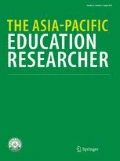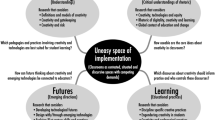Abstract
Recognizing its importance, most countries have prioritized creative thinking as a critical ability that students need to develop before they enter the workforce. Thailand is no exception. For teachers to create learning environments that foster students’ creativity, teachers need a research-based understanding of creativity. Eighty-nine Thai in-service teachers responded to an online questionnaire that surveyed their conceptions of creativity and use of technology to foster creativity in their classrooms. The results of the survey revealed that the Thai in-service teachers were less readily recognizing the mini-c and Pro-c. Also, they did not seem to deem originality/novelty as a necessary criterion for creativity. More results of the survey will be further discussed.
Similar content being viewed by others
References
Barron, F., & Harrington, D. M. (1981). Creativity, intelligence, and personality. Annual Review of Psychology,32, 439–476.
Beghetto, R. A. (2007). Does creativity have a place in classroom discussions: Prospective teachers’ response preferences. Thinking Skills and Creativity,2, 1–9.
Boden, M. A. (1994). What is creativity. In M. A. Boden (Ed.), Dimensions of creativity (pp. 75–117). Cambridge, MA: MIT Press.
Bolden, D. S., Harries, T. V., & Newton, D. P. (2010). Pre-service primary teachers’ conceptions of creativity in mathematics. Educational Studies in Mathematics,73, 143–157.
Buaraphan, K. (2009). Thai in-service science teachers’ conceptions of the nature of science. Journal of Science and Mathematics Education in Southeast Asia,32(2), 188–217.
Caldwell, K., & Hung, W. (2016, April). The meaning of creativity: A phenomenological study of secondary school teachers’ perspectives in western Canada. Paper presented at AERA 2016 annual meeting, Washington DC, April 8–12, 2016.
Cattell, R. B. (1971). Abilities: Their structure, growth, and action. Boston: Houghton Mifflin.
Csikszentmihalyi, M. (1988). Society, culture, and person: A systems view of creativity. In R. J. Sternberg (Ed.), The nature of creativity (pp. 325–339). New York: Cambridge University Press.
Csikszentmihalyi, M. (2006). A systems perspective on creativity. In J. Henry (Ed.), Creative management and development (pp. 3–17). London: Sage.
Diakidoy, I.-A. N., & Kanari, E. (1999). Student teachers’ beliefs about creativity. British Educational Research Journal,25(2), 225–243.
Eyadat, W. M., & Eyadat, Y. A. (2010). Instructional technology and creativity among university students: The missing link. World journal on Educational Technology,2(2), 87–99.
Eysenck, H. J. (1994). The measurement of creativity. In M. A. Boden (Ed.), Dimensions of creativity (pp. 199–242). Cambridge, MA: MIT Press.
Gardner, H. (1994). The creators’ patterns. In M. A. Boden (Ed.), Dimensions of creativity (pp. 143–158). Cambridge, MA: MIT Press.
Geary, D. C. (2005). The origin of mind: Evolution of brain, cognition, and general intelligence. Washington, DC: American Psychological Association.
Gralewski, J., & Karwowski, M. (2013). Polite girls and creative boys? Students’ gender moderates accuracy of teachers’ ratings of creativity. The Journal of Creative Behavior,47, 290–304.
Henrkisen, D., DeSchryver, M., & Mishra, P. (2015). Rethink technology & creativity in the 21st century: Transform and transcend: Synthesis as a trans-disciplinary approach to thinking and learning. TechTrend,59(4), 5–9.
Jonassen, D. H. (2000). Computers as mindtools for schools: Engaging critical thinking. Upper Saddle River, NJ: Prentice Hall.
Kampylis, P., Berki, E., & Saariluoma, P. (2009). In-service and prospective teachers’ conceptions of creativity. Thinking Skills and Creativity,4, 15–29.
Kaufman, J. C., & Baer, J. (2002). Could Steven Spielberg manage the Yankees? Creative thinking in different domains. The Korean Journal of Thinking & Problem Solving,12(2), 5–14.
Kaufman, J. C., & Beghetto, R. A. (2009). Beyond big and little: The four C model of creativity. Review of General Psychology,13, 1–12.
Kaufman, J. C., & Beghetto, R. A. (2013). Do people recognize the four Cs: Examining layperson conceptions of creativity. Psychology of Aesthetics, Creativity, and the Arts,7(3), 229–236.
Kokotsaki, D. (2012). Pre-service student–teachers’ conceptions of creativity in the primary music classroom. Research studies in Music Education,34(2), 129–156.
Lajoie, S. (2000). Computers as cognitive tools: No more walls (Vol. II). Mahwah, NJ: Lawrence Erlbaum Associates.
Matthews, M. S. (2015). Creativity and leadership’s role in gifted identification and programming in the USA: A pilot study. Asia Pacific Education Review, 16, 247–256.
Mayer, R. E. (1999). Fifty years of creativity research. In R. J. Sternberg (Ed.), Handbook of creativity (pp. 449–460). New York: Cambridge University Press.
Mednick, S. A. (1962). The associative basis of the creative process. Psychological Review,69, 220–232.
Millar, G. W., & Torrance, E. P. (2002). Are low career expectations shortchanging girls? Understanding Our Gifted,14(3), 22–26.
Ministry of ICT. (2009). ICT for education masterplan (2007–2011). Bangkok: Ministry of ICT.
Mullet, D. R., Willerson, A., Lamb, K. N., & Kettler, T. (2016). Examining teacher perceptions of creativity: A systematic review of the literature. Thinking Skills and Creativity,21, 9–30.
Nickerson, R. (1999). Enhancing creativity. In R. J. Sternberg (Ed.), Handbook of creativity (pp. 189–212). New York: Cambridge University Press.
Parise, S., Whelan, E., & Todd, S. (2015). How Twitter users can generate better ideas. MIT Sloan Management Review,56(4), 21–25.
Sankham, V. (2015). Project with OECD to boost students’ creativity and critical thinking. The Nation, December 26. Retrieved from http://annx.asianews.network/content/thailand-launches-project-oecd-boost-students%E2%80%99-creativity-and-critical-thinking-6196.
Sawyer, K. (2003). Emergence in creativity and development. In K. Sawyer (Ed.), creativity and development (pp. 12–60). Oxford: Oxford University Press.
Sawyer, K. (2012). Explaining creativity: The science on human innovation (2nd ed.). Oxford: Oxford University Press.
Scott, C. L. (1999). Teachers’ biases toward creative children. Creativity Research Journal,12, 321.
Sinlarat, P., Rachapaetayakom, J., & Swatevacharkul, R. (October, 2013). Education for the future: Pedagogical approaches for Thailand. Presentation at Dhurakij Pundit University, Bangkok, Thailand, October 16–18.
Sternberg, R. J., & Lubart, T. I. (1991). Creating creative minds. Phi Delta Kappan,8(72), 608–614.
Thammanit, C., & Bussracumpakorn, V. (2007). Creativity Problems of the Thai adolescents: Body–Brain–Mind Approach.
Tugrul, B., Uysal, H., Gukhan, G., & Okutan, N. S. (2014). Picture of the creativity. Procedia—Social and Behavioral Sciences,116, 3096–3100.
Vernon, P. E. (1989). The nature-nurture problem in creativity. In J. A. Glover, R. R. Ronning, & C. R. Reynolds (Eds.), Handbook of creativity (pp. 93–110). New York: Plenum Press.
Yadav, A., & Cooper, S. (2017). Fostering creativity through computing. Communications of the ACM,60(2), 31–33.
Author information
Authors and Affiliations
Corresponding author
Additional information
Publisher's Note
Springer Nature remains neutral with regard to jurisdictional claims in published maps and institutional affiliations.
Appendix
Rights and permissions
About this article
Cite this article
Hung, W., Sitthiworachart, J. In-Service Teachers’ Conception of Creativity and Its Relation with Technology: A Perspective from Thailand. Asia-Pacific Edu Res 29, 137–146 (2020). https://doi.org/10.1007/s40299-019-00460-6
Published:
Issue Date:
DOI: https://doi.org/10.1007/s40299-019-00460-6




